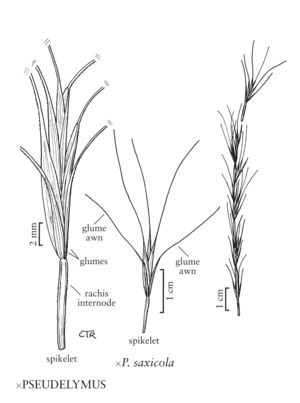Difference between revisions of "×Pseudelymus saxicola"
FNA>Volume Importer |
GeoffLevin (talk | contribs) m (GeoffLevin moved page ×pseudelymus saxicoia to ×Pseudelymus saxicola: Fixing typos in accepted name) |
||
| (7 intermediate revisions by 3 users not shown) | |||
| Line 1: | Line 1: | ||
{{Treatment/ID | {{Treatment/ID | ||
| − | |accepted_name= | + | |accepted_name=×Pseudelymus saxicola |
|accepted_authority=(Scribn. & J.G. Sm.) Barkworth & D.R. Dewey | |accepted_authority=(Scribn. & J.G. Sm.) Barkworth & D.R. Dewey | ||
|publications= | |publications= | ||
|basionyms= | |basionyms= | ||
|synonyms={{Treatment/ID/Synonym | |synonyms={{Treatment/ID/Synonym | ||
| − | |name= | + | |name=×Agrositanion saxicola |
| − | |authority= | + | |authority= |
| + | |rank=species | ||
}} {{Treatment/ID/Synonym | }} {{Treatment/ID/Synonym | ||
|name=Elymus saxicola | |name=Elymus saxicola | ||
| − | |authority= | + | |authority= |
| + | |rank=species | ||
}} | }} | ||
|hierarchy=Poaceae;Poaceae subfam. Pooideae;Poaceae tribe Triticeae;×pseudelymus;×pseudelymus saxicoia | |hierarchy=Poaceae;Poaceae subfam. Pooideae;Poaceae tribe Triticeae;×pseudelymus;×pseudelymus saxicoia | ||
| − | |hierarchy_nav=<div class="higher-taxa"><div class="higher-taxon"><small>family</small>[[Poaceae]]</div><div class="higher-taxon"><small>subfamily</small>[[Poaceae subfam. Pooideae]]</div><div class="higher-taxon"><small>tribe</small>[[Poaceae tribe Triticeae]]</div><div class="higher-taxon"><small>genus</small>[[×pseudelymus]]</div><div class="higher-taxon"><small>species</small>[[ | + | |hierarchy_nav=<div class="higher-taxa"><div class="higher-taxon"><small>family</small>[[Poaceae]]</div><div class="higher-taxon"><small>subfamily</small>[[Poaceae subfam. Pooideae]]</div><div class="higher-taxon"><small>tribe</small>[[Poaceae tribe Triticeae]]</div><div class="higher-taxon"><small>genus</small>[[×pseudelymus]]</div><div class="higher-taxon"><small>species</small>[[×Pseudelymus saxicola]]</div></div> |
|volume=Volume 24 | |volume=Volume 24 | ||
|mention_page= | |mention_page= | ||
| Line 22: | Line 24: | ||
-->{{Treatment/Body | -->{{Treatment/Body | ||
|distribution=Colo.;N.Mex.;Calif.;Oreg.;Wyo.;Mont.;Utah;Wash.;Ariz.;Idaho;Nev.;S.Dak. | |distribution=Colo.;N.Mex.;Calif.;Oreg.;Wyo.;Mont.;Utah;Wash.;Ariz.;Idaho;Nev.;S.Dak. | ||
| − | |discussion=<p> | + | |discussion=<p>×<i>Pseudelymus saxicola</i> consists of hybrids between <i>Pseudoroegneria spicata</i> and <i>Elymus elymoides</i>. It is a rather common hybrid in western North America. It differs from <i>E. albicans</i>, which is thought to be derived from hybrids between <i>P. spicata</i> and <i>E. lanceolatus</i>, in lacking rhizomes, having longer awns on its glumes and lemmas, and having disarticulating rachises. It is more likely to be confused with <i>E. xsaundersii</i>, but differs in its longer glume and lemma awns.</p> |
|tables= | |tables= | ||
|references= | |references= | ||
| Line 30: | Line 32: | ||
-->{{#Taxon: | -->{{#Taxon: | ||
| − | name= | + | name=×Pseudelymus saxicola |
| − | |||
|authority=(Scribn. & J.G. Sm.) Barkworth & D.R. Dewey | |authority=(Scribn. & J.G. Sm.) Barkworth & D.R. Dewey | ||
|rank=species | |rank=species | ||
|parent rank=genus | |parent rank=genus | ||
| − | |synonyms= | + | |synonyms=×Agrositanion saxicola;Elymus saxicola |
|basionyms= | |basionyms= | ||
|family=Poaceae | |family=Poaceae | ||
| + | |illustrator=Cindy Roché | ||
| + | |illustration copyright=Utah State University | ||
|distribution=Colo.;N.Mex.;Calif.;Oreg.;Wyo.;Mont.;Utah;Wash.;Ariz.;Idaho;Nev.;S.Dak. | |distribution=Colo.;N.Mex.;Calif.;Oreg.;Wyo.;Mont.;Utah;Wash.;Ariz.;Idaho;Nev.;S.Dak. | ||
|reference=None | |reference=None | ||
| Line 43: | Line 46: | ||
|publication year= | |publication year= | ||
|special status= | |special status= | ||
| − | |source xml=https:// | + | |source xml=https://bitbucket.org/aafc-mbb/fna-data-curation/src/200273ad09963decb8fc72550212de541d86569d/coarse_grained_fna_xml/V24/V24_403.xml |
|subfamily=Poaceae subfam. Pooideae | |subfamily=Poaceae subfam. Pooideae | ||
|tribe=Poaceae tribe Triticeae | |tribe=Poaceae tribe Triticeae | ||
|genus=×pseudelymus | |genus=×pseudelymus | ||
| − | |species= | + | |species=×Pseudelymus saxicola |
}}<!-- | }}<!-- | ||
-->[[Category:Treatment]][[Category:×pseudelymus]] | -->[[Category:Treatment]][[Category:×pseudelymus]] | ||
Latest revision as of 15:09, 14 December 2022
Plants not rhizomatous. Culms 0.8-1 mm thick; ligules 0.2-0.4 mm; blades 1.5-2 mm wide. Spikes 7-14 cm, with 1 spikelet per node; internodes 7-9 mm. Spikelets 12-15 mm excluding the awns; disarticulation beneath the florets, sometimes also in the rachises. Glumes 15-21 mm including the awns, glume bodies 6-8 mm long, 0.7-1 mm wide, (1)3-4-veined; lemmas 10-11 mm excluding the awns, (14)18-37 mm including the awns, apices often bifid; anthers about 2.5 mm.
Distribution
Colo., N.Mex., Calif., Oreg., Wyo., Mont., Utah, Wash., Ariz., Idaho, Nev., S.Dak.
Discussion
×Pseudelymus saxicola consists of hybrids between Pseudoroegneria spicata and Elymus elymoides. It is a rather common hybrid in western North America. It differs from E. albicans, which is thought to be derived from hybrids between P. spicata and E. lanceolatus, in lacking rhizomes, having longer awns on its glumes and lemmas, and having disarticulating rachises. It is more likely to be confused with E. xsaundersii, but differs in its longer glume and lemma awns.
Selected References
None.
